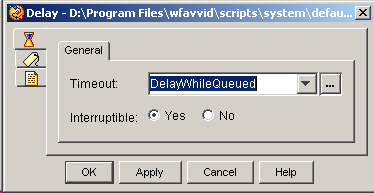The Delay Step
Continue building the Queued output branch of the Select Resource step by dragging a Delay step from the General palette into the Design pane and dropping it into the Queued icon under the Select Resource step.
Next, configure the Delay step to set the length of time, in seconds, before the subsequent Goto step sends the call back to the beginning of the queue loop.
Figure shows the configured Delay customizer window.

-
Delay time—DelayWhileQueued
This variable stores the length of time for the delay.
-
Interruptible—Yes
An available resource interrupts the Delay step and the Select Resource step connects the call.
The caller hears nothing while the Delay step is waiting for the specified amount of time to elapse.
Tip | If the administrator has configured a Music On Hold server in Cisco Unified CallManager, you can place a Call Hold step just before the Delay step and a Call Unhold step just after the Delay step to play music to the caller while on hold. (You use the Call Unhold step to retrieve the call so that the script plays QueuePrompt before placing the call on hold again.) This option does not increase the CPU usage of the Cisco Unified CCX server, because the music streaming is performed by the Music On Hold server and not by the Cisco Unified CCX server. You can also replace the Delay step with a Play Prompt step that plays a prompt recorded with the same amount of music as required by the original Delay step. However, this option increases CPU usage because the Cisco Unified CCX server streams this recorded music prompt to all callers in queue. |